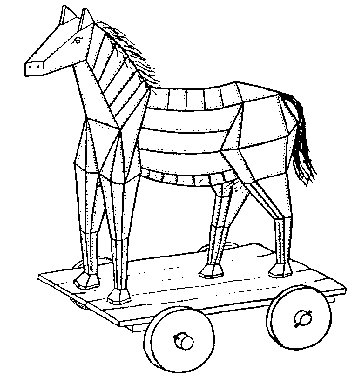The whole story:

Life, Money
and Illusion
Advantage of the Question of Direction
The Question of Direction is deceptive in its simplicity. Its main advantage is the ease with which a single either-or question can be presented. Once the question is understood, however, the sustainability option unfolds into a broad spectrum of concerns. Each area of interest has a constituency that can offer details for understanding and solving the particular problems they focus on.

Just presenting the reference for sustainability has a positive impact. The Strategy link outlines the basic process by which understanding develops and the results we have come to expect from distributing cards and stimulating discussion about sustainability as an alternative to conventional goals.
A Tool for Change
with our hopes and dreams for the
future, we can forge a useful tool.
The tool is a wedge, which,
through the single word,
can introduce an
environmental
world view
and
dislodge
entrenched beliefs
from a bygone era.
Is this what we mean by sustainability?
If it is not, upon what point or points do we disagree?
For what reasons?
Is there anything missing?
Sustainability reference:
Sustainable activities:
1 - use materials in continuous cycles.
2 - use continuously reliable sources of energy.
3 - come mainly from the qualities of being human (i.e. creativity, communication, movement, appreciation, and spiritual and intellectual development).
Non sustainable activities:
4 - require continual inputs of non-renewable resources.
5 - use renewable resources faster than their rate of renewal.
6 - cause cumulative degradation of the environment.
7 - require resources in quantities that undermine other people's well-being.
8 - lead to the extinction of other life forms.
Brief explanations of these eight points are found at the sustainability link.
A sub index of concerns organized around the sustainability outline follow here.
Solutions
1) Cyclic Material Use:Natural Cycles and Recycling
2) Safe Reliable Energy:
Renewable Energy, Conservation, Substitution, Interim Measures
3) Life-Based Activities:
Community, Health, Creativity, Communication, Coordination ( sport, dance etc.)
Appreciation, Learning, Spiritual Development, Voluntary Simplicity
Problems
4) Depletion of Finite Resources:Fuels, Minerals, Species, Cultures
5) Overuse of Renewable Resources:
Forests, Fish, Soil Fertility, Public Money
6) Pollution:
Atmosphere, Water, Soils, Nuclear, Awareness
7) Inequity:
Domination and Exploitation of: the Poor, Women, Aboriginal People, Other Groups,
Degradation Through Desperation
Lack or Failure of Democracy,
Failure to Consider Future Generations
8) Species Loss:
Endangered Species, Endangered Spaces (habitat)
In addition to issues which link directly to the eight specific areas, there are issues which are obviously a part of the sustainability challenge but which overlap to the extent that they are best accessed in their own fields.
